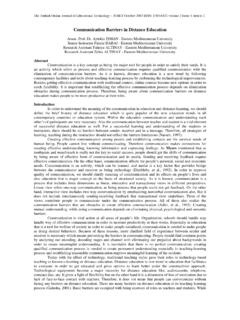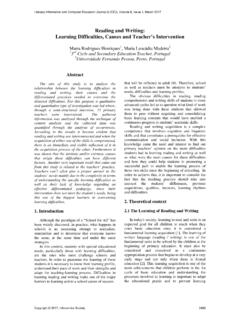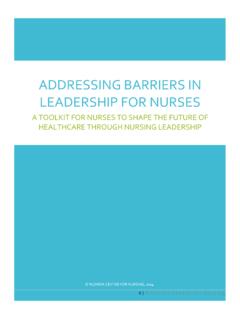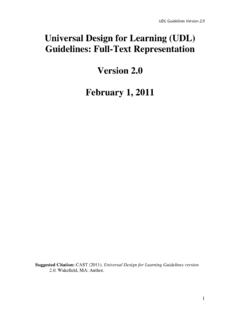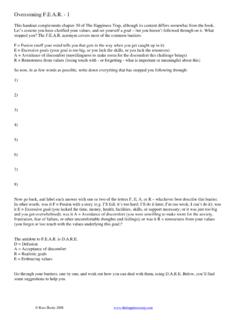Transcription of BRIDGING THE DIGITAL GENDER DIVIDE - OECD
1 BRIDGING THE DIGITAL GENDER DIVIDEINCLUDE, UPSKILL, INNOVATE This report of the Organisation for Economic Co-operation and Development has been prepared at the request of the Australian government. It aims to further strengthen the evidence base in support of G20 DIGITAL Economy Task Force discussions on the equitable participation of women in the DIGITAL economy. This report is issued under the responsibility of the Secretary-General of the OECD. The opinions expressed and arguments employed herein do not necessarily reflect the official views of OECD Member countries or of the G20.
2 This document, as well as any data and any map included herein, are without prejudice to the status of or sovereignty over any territory, to the delimitation of international frontiers and boundaries and to the name of any territory, city or area. The statistical data for Israel are supplied by and under the responsibility of the relevant Israeli authorities. The use of such data by the OECD is without prejudice to the status of the Golan Heights, East Jerusalem and Israeli settlements in the West Bank under the terms of international law. OECD, 2018 The figure on the cover displays the core part of the co-authorship network emerging among the top 1 000 most downloaded package authors of the R open-source software.
3 Each point represents a male author. Female authors are denoted by a stylised woman icon. The network clearly shows that female authors are relatively few, and are poorly represented within the core network of package co-authorship. This report was prepared by staff in the OECD Directorate for Science, Technology and Innovation (STI), with contributions from the Directorate for Education and Skills (EDU) and the Directorate for Employment, Labour and Social Affairs (ELS) of the OECD. The work was co-ordinated by Mariagrazia Squicciarini from the OECD STI Directorate, headed by Director Andrew Wyckoff and Deputy Director Dirk Pilat.
4 The leadership and oversight of Gabriela Ramos, OECD Sherpa, and the co-ordination and peer review provided by Raffaella Centurelli, OECD Sherpa Office, is gratefully acknowledged. Authors and contributors from the OECD Secretariat include, in alphabetical order: Francesca Borgonovi, Raffaella Centurelli, H l ne Dernis, Robert Grundke, Peter Horv t, St phanie Jamet, Mark Keese, Anna-Sophie Liebender, Luca Marcolin, David Rosenfeld and Mariagrazia Squicciarini. The International Telecommunication Union (ITU), the United Nations University (UNU) and the Australian government, provided valuable comments.
5 Many thanks to Sarah Box for her valuable feedback and advice, and to Anna-Sophie Liebender and Angela Gosmann for their help in editing and formatting the report. Generous financial support for this work from the Australian government is gratefully acknowledged. GENDER equality is not only a fundamental human right. It is also a keystone of a prosperous, modern economy that provides sustainable inclusive growth. Recognising that GENDER equality is essential for ensuring that men and women can contribute fully for the betterment of societies and economies at large, G20 Leaders first committed to women s full economic and social participation in Los Cabos in 2012.
6 They then set the ambitious goal to reduce the GENDER gap in labour market participation by 25% by 2025 (the 25x25 target) at the 2014 Brisbane Summit, and committed to implementing a set of policies to improve the quality of women s employment and the provision of support services. Since then, as documented by the OECD, most G20 countries have made progress, but much remains to be done. In 2016, the gap in labour market participation rates between men and women aged 15-64 was around 26% for G20 economies. Today the DIGITAL transformation provides new avenues for the economic empowerment of women and can contribute to greater GENDER equality.
7 The Internet, DIGITAL platforms, mobile phones and DIGITAL financial services offer leapfrog opportunities for all and can help bridge the DIVIDE by giving women the possibility to earn additional income, increase their employment opportunities, and access knowledge and general information. We need to seize this opportunity to foster greater GENDER equality in the labour market, boost economic growth and build a more inclusive, DIGITAL world. The road ahead is uphill: today worldwide some 327 million fewer women than men have a smartphone and can access the mobile Internet.
8 Women are under-represented in ICT jobs, top management and academic careers and, as shown in this report, men are four times more likely than women to be ICT specialists. At 15 years of age, on average, only of girls wish to become ICT professionals, compared to 5% of boys. Women-owned start-ups receive 23% less funding and are 30% less likely to have a positive exit compared to male-owned businesses. This report explores a range of factors that underpin the DIGITAL GENDER DIVIDE , bolsters the evidence base for policy making and provides policy directions for consideration by all G20 governments.
9 It has been prepared by the OECD at the request of the Australian Government to support advancement of the 2017 G20 Roadmap for Digitalisation: Policies for a DIGITAL Future, in particular its aim to support the equitable participation of women in the DIGITAL economy. It complements the initiative of the 2018 Argentinian G20 Presidency to share policies, actions and national practices that have had a significant and measurable impact in BRIDGING the DIGITAL GENDER DIVIDE , while supporting Argentina s mainstreaming of GENDER across the G20 agenda. The report finds that hurdles to access, affordability, lack of education as well as inherent biases and socio-cultural norms curtail women and girls ability to benefit from the opportunities offered by the DIGITAL transformation.
10 In addition, girls relatively lower educational enrolment in disciplines that would allow them to perform well in a DIGITAL world such as science, technology, engineering and mathematics, as well as information and communication technologies coupled with women s and girls more limited use of DIGITAL tools could lead to widening gaps and greater inequality. Acting now to reverse these trends can pay off: the reports finds that greater inclusion of women in the DIGITAL economy and increased diversity bring value, both social and economic. For instance, inventions arising out of mixed teams are more economically valuable and have higher impact than those in which only men are involved.











